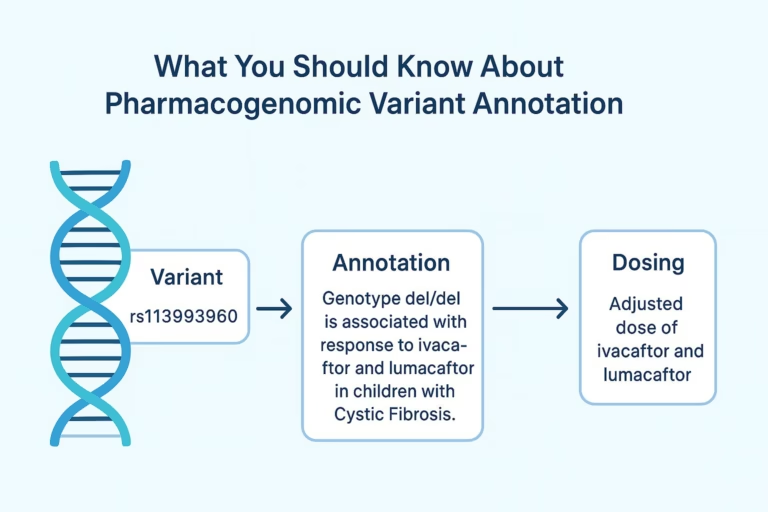Grand View Research has just released its latest report on the pharmacogenomics technology market, offering fresh insights into one of the fastest-growing areas of precision medicine. According to the study, the global market was valued at USD 7.63 billion in 2024 and is projected to reach USD 12.38 billion by 2030, expanding at a CAGR of 8.1% between 2025 and 2030.
This growth trajectory underscores the profound transformation happening in healthcare. As medicine steadily shifts away from the “one-size-fits-all” model, pharmacogenomics is becoming a cornerstone of precision medicine—where treatments are tailored to the genetic makeup of each individual.
The stakes are high: adverse drug reactions account for an estimated 5–7% of hospital admissions globally and are a leading cause of morbidity and mortality. By integrating genetic insights into prescribing decisions, pharmacogenomics not only improves outcomes but also reduces unnecessary healthcare costs. Governments, pharmaceutical companies, and healthcare providers are aligning around this vision, accelerating both adoption and innovation.
Seven Key Highlights from the Report
- Market Size & Growth – Valued at USD 7.63 billion in 2024, the market is on track to reach USD 12.38 billion by 2030 (CAGR 8.1%).
- Oncology Leads – Oncology dominated with 39.8% share in 2024, driven by targeted therapies and companion diagnostics.
- Cardiovascular Boom – Cardiovascular disease (CVD) is projected to be the fastest-growing therapeutic area, reflecting the global burden of heart disease.
- PCR at the Core – Polymerase Chain Reaction (PCR) remained the largest technology segment, while sequencing and multiomics drive innovation.
- Regional Outlook – North America leads with 36.8% share, while Asia Pacific is the fastest-growing region (CAGR 9.7%).
- Industry Dynamics – High innovation, M&A activity, and strategic collaborations define the competitive landscape.
- Key Players Shaping the Market – Global leaders including QIAGEN, Thermo Fisher, Roche, Oxford Nanopore, and Pfizer continue to advance the field through new tools, partnerships, and acquisitions.
You can access the report highlights here.
Precision Medicine as a Key Driver
The rise of pharmacogenomics is closely tied to the global push toward personalized healthcare. Traditional drug development relies on population averages, which often leads to inefficiency—some patients respond well to drugs, others experience side effects, and many see no effect at all. This inefficiency costs the pharmaceutical industry billions and places a heavy burden on healthcare systems.
Pharmacogenomics addresses this by using genetic markers to predict drug response. The implications are massive:
- Fewer Adverse Drug Reactions (ADRs): ADRs are among the top 10 causes of death in developed countries. Genetic testing can reduce these events by helping clinicians prescribe safer alternatives.
- Improved Trial Efficiency: By selecting patients most likely to respond, clinical trials become faster and less costly.
- Optimized Healthcare Spending: Precision prescribing reduces wasteful spending on ineffective treatments, redirecting resources toward therapies that work.
Government initiatives are also fueling growth. Programs such as the U.S. All of Us Research Program and the UK Genomic Medicine Service are investing heavily in population-wide genetic databases. These efforts not only support pharmacogenomics research but also encourage integration into routine care.
Oncology Dominates the Pharmacogenomics Market
Oncology dominated the pharmacogenomics market in 2024, capturing 39.8% of revenue. The reason is clear: cancer is inherently a genetic disease. Tumor mutations determine both disease progression and treatment response.
Pharmacogenomics has become indispensable in cancer care through:
- Targeted therapies: Drugs like trastuzumab (HER2-positive breast cancer) or EGFR inhibitors (lung cancer) are prescribed based on genetic biomarkers.
- Immunotherapies: Pharmacogenomic profiling helps identify patients likely to benefit from checkpoint inhibitors such as pembrolizumab.
- Companion diagnostics: Tests that identify mutations (e.g., BRCA, KRAS, ALK) are now standard before prescribing certain drugs.
Clinical success stories abound. For instance, patients with chronic myeloid leukemia (CML) benefit from tyrosine kinase inhibitors (TKIs) only if they carry the BCR-ABL fusion gene—a genetic insight that turned a once-fatal cancer into a largely manageable disease.
Pharmacogenomics also supports the growing field of liquid biopsies, where circulating tumor DNA (ctDNA) is analyzed to guide treatment decisions in real time, reducing the need for invasive tissue biopsies.
Cardiology Most Promising in the Pharmacogenomics Market
While oncology dominates in revenue, cardiology is set to grow fastest over the forecast period. Cardiovascular diseases (CVDs) remain the leading cause of death globally, responsible for 17.9 million deaths each year. The stakes are high for improving treatment efficacy.
Examples of pharmacogenomics in cardiology include:
- Warfarin sensitivity: Variants in the CYP2C9 and VKORC1 genes affect how patients metabolize warfarin, a common blood thinner. Testing reduces dangerous bleeding risks.
- Clopidogrel resistance: Genetic testing can identify patients who won’t respond to the antiplatelet drug clopidogrel, enabling doctors to prescribe alternatives.
- Statin intolerance: Variants in SLCO1B1 are linked to statin-induced muscle toxicity, helping physicians personalize lipid-lowering therapy.
As healthcare systems seek to reduce hospitalizations and prevent costly cardiovascular events, adoption of pharmacogenomic testing in cardiology is expected to accelerate sharply.
Technology Landscape: PCR as the Backbone, Sequencing as the Future
The technology underpinning pharmacogenomics is as important as the therapies it enables.
- Polymerase Chain Reaction (PCR): PCR remains the gold standard due to its precision, affordability, and scalability. It dominates the market as the backbone of genetic testing.
- Digital PCR (dPCR): Offers even greater sensitivity, making it ideal for detecting rare mutations in oncology or infectious diseases. Firalis Molecular Precision’s 2025 acquisition of QuantStudio Absolute Q demonstrates rising adoption.
- Next-Generation Sequencing (NGS): Enables large-scale genomic profiling at decreasing costs. Oxford Nanopore and Twist Bioscience’s 2024 collaboration exemplifies innovation in this space.
- Immunohistochemistry (IHC): Still essential in cancer diagnostics for detecting protein biomarkers; expected to post a CAGR of 8.5% through 2030.
Each technology carries trade-offs. PCR is cost-effective but limited in scope, while NGS provides depth but requires significant infrastructure and expertise. As sequencing costs continue to fall, however, NGS is expected to drive the next major wave of clinical adoption.
Regional Outlook: North America Leads, Asia Pacific Rises Fastest
North America accounted for 36.8% of global revenue in 2024, driven by advanced infrastructure, strong regulatory support, and concentration of pharmaceutical companies. The FDA has been proactive in publishing pharmacogenomic guidelines, which streamlines integration into clinical workflows.
Europe contributed 28.6% of revenue. Countries like the UK and Norway are spearheading government-backed genomic initiatives. Germany and France are also investing heavily in integrating pharmacogenomics into public healthcare systems.
Asia Pacific is the fastest-growing region (CAGR 9.7%), fueled by:
- High burden of chronic diseases.
- Genetic diversity ideal for research.
- Expanding government initiatives in countries like China, Japan, and India.
Latin America and the Middle East & Africa (MEA) are still emerging but present significant opportunities. Brazil and Mexico are leading in LATAM with expanding genomic research capabilities, while South Africa and Saudi Arabia are laying the groundwork for regional genomic medicine programs. These markets face challenges—such as limited funding and infrastructure—but growing collaborations with global players could accelerate adoption.
Industry Dynamics: Innovation, M&A, and Collaborations
The pharmacogenomics industry thrives on innovation and partnerships. AI and machine learning are now integral, enabling faster interpretation of vast genomic datasets. For example, predictive algorithms can identify gene–drug interactions across diverse populations, reducing disparities in access to precision medicine.
M&A remains a defining feature. QIAGEN’s 2023 acquisition of Verogen strengthened its portfolio in applied genomics. Similar moves are expected as larger firms acquire startups specializing in companion diagnostics or niche sequencing technologies.
Collaborations are equally critical. Startups bring agility and innovation, while large pharmaceutical companies provide resources and market access. Partnerships such as the Oxford Nanopore–Twist Bioscience beta program exemplify how cross-industry collaboration accelerates innovation.
Key Players Driving the Pharmacogenomics Market Forward
The competitive landscape includes a mix of global leaders and nimble innovators:
- QIAGEN – Launched Pharmacogenomic Insights (PGXI) in October 2024 to support researchers with data interpretation.
- Oxford Nanopore & Twist Bioscience – Driving sequencing innovation through their 2024 beta program.
- Thermo Fisher Scientific – Expanding multiomic solutions through acquisitions and platform development.
- Roche & Foundation Medicine – Leaders in oncology diagnostics, particularly companion testing.
- Leica Biosystems – Advanced colorectal cancer screening with its BOND MMR Antibody Panel.
- Pfizer & Abbott – Integrating pharmacogenomics into broader drug pipelines and diagnostic systems.
These players set the pace, but smaller startups focusing on niche biomarkers or AI-driven platforms are increasingly vital to the ecosystem.
Conclusion
The pharmacogenomics technology market is not just growing—it is reshaping the future of healthcare. With oncology as the current anchor, cardiology rising quickly, and new technologies like NGS, dPCR, and AI enabling deeper insights, pharmacogenomics is accelerating toward mainstream clinical adoption.
Regional growth patterns show that while North America continues to lead, Asia Pacific is emerging as a critical driver, reflecting a more globalized innovation landscape. Meanwhile, M&A, collaborations, and government-backed initiatives will continue to expand the reach and impact of pharmacogenomics worldwide.
The opportunity is vast: reducing adverse drug reactions, improving patient outcomes, cutting healthcare costs, and making precision medicine a global standard. The next five years will be decisive. For healthcare providers, policymakers, and industry leaders, the message is clear: pharmacogenomics is not a niche—it is the future of medicine. Those who invest now will shape tomorrow’s healthcare.
Reference




